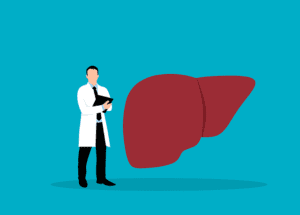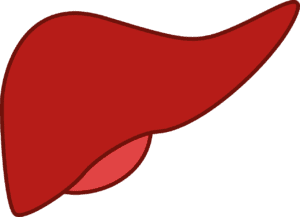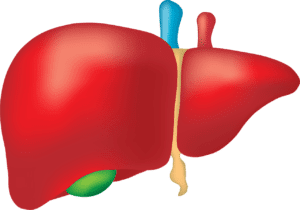Primary Liver Cancer
What is primary liver cancer?
Most of the time, when cancer is found in the liver, it didn’t actually start there, but has spread from somewhere else in the body. This is referred to as secondary liver cancer. This entry only covers information on primary liver cancer, which is cancer that originates in the cells of the liver. Medically, only primary liver cancer cases are referred to as liver cancer. The liver is an organ located in the upper right portion of the abdomen, beneath the diaphragm and above the stomach. It has many important functions, including cleaning toxins from blood, making bile that helps digest fat, making substances that help blood clot, and storing sugar, which the body uses for energy. Secondary liver cancer is more common than primary liver cancer. Primary liver cancer affects more men than women. It is also much more common in sub-Saharan African countries and Southeast Asian countries than in the United States, where it is considered rare. People who have been infected by the hepatitis B virus (HBV) and/or the hepatitis C virus (HCV) are at a higher risk of developing liver cancer.What are the types of primary liver cancer?
- Hepatocellular carcinoma: The most common type. It occurs in the tissue of the liver.
- Cholangiocarcinoma: Cancer that starts in the cells that line the small bile ducts (tubes within the liver that carry bile to the gallbladder).
- Very rare types: Hepatoblastomas, angiosarcomas, and hemangiosarcomas.
What are the symptoms of primary liver cancer?
Most patients don’t show symptoms in early stages of liver cancer. Symptoms include:- A lump on the right side of the body
- Pain in abdomen or near the right shoulder blade
- Unintentional weight loss
- Loss of appetite
- Nausea and vomiting
- Weakness
- Fatigue
- Abdominal swelling
- Yellowing of the skin and eyes
- Itching
- Fever
- White, chalky stool and dark urine
What causes primary liver cancer?
Normal, healthy cells grow at a steady rate, and die at a set time. However, sometimes healthy cells develop abnormalities; they grow and multiply at an out of control rate, and take much longer to die. When this happens to cells in the liver, they accumulate into a tumor there. While we know many risk factors for liver cancer, how these lead to the cell mutation that causes the disease is not fully understood. Untreated liver cancer can also spread to nearby parts of the body. There are many risk factors for liver cancer. They include: chronic infection with hepatitis B virus (HBV) and/or hepatitis C virus (HCV); cirrhosis; liver diseases like hemochromatosis and Wilson’s disease; diabetes; nonalcoholic fatty liver disease; exposure to aflatoxins (poisons produced by molds that grow on poorly stored crops); obesity; and excessive alcohol consumption.How is primary liver cancer diagnosed?
Liver cancer is diagnosed using the following procedures:- Physical exam
- Recording of medical history
- Blood tests
- CT scan
- MRI
- Biopsy
- Serum tumor marker test
- Ultrasound
- Laparoscopy
What are the stages of primary liver cancer?
Doctors use the information obtained during diagnosis to assign a patient’s cancer a stage, which describes how widespread the cancer is. There are multiple staging methods for liver cancer, and not all doctors use the same system. One method uses Roman numbers, the others, letters. The stages for the Roman numerical system are:- Stage I: There is a single tumor (any size) that has not spread into any blood cells or lymph nodes.
- Stage II: There can be a single tumor (any size) or multiple tumors (5 cm/2 inches across) that have spread into neighboring blood vessels.
- Stage III: There is more than one tumor (one at least 5 cm/2 inches across), and they have likely grown into a major vein in the liver or a nearby organ.
- Stage IV: Tumors are any size or number and they have spread to faraway parts of the body.
What are the treatments for primary liver cancer?
Treatment depends on the stage of the cancer, how well the liver is working, the patient’s health, and the patient’s personal preferences. Treatment includes, but is not limited to:- Surgery
- Localized treatments
- Radiation therapy
- Liver transplant
- Ablation therapy
- Targeted drug therapy
- Supportive care focused on providing relief from pain
Where can I find out more about primary liver cancer?
Primary Liver Cancer Articles

Toripalimab Combined with Bevacizumab Meets Primary Endpoint for Advanced Hepatocellular Carcinoma
Rose Duesterwald
July 26, 2024
Read More »

ASCO GI Symposium: Fostrox-Lenvima Combo Treatment Show Clinical Benefit in Treating HCC
Jessica Lynn
February 8, 2024
Read More »

Positive Signs from Interim Data in Early Hepatocellular Carcinoma Trial
James Moore
September 7, 2023
Read More »




New Combination Therapy Approved in US for Unresectable Hepatocellular Carcinoma
James Moore
December 13, 2022
Read More »

INTERVIEW: Omega Therapeutics’ Mahesh Karande Discusses OTX-2002 for Hepatocellular Carcinoma
Jessica Lynn
December 5, 2022
Read More »



